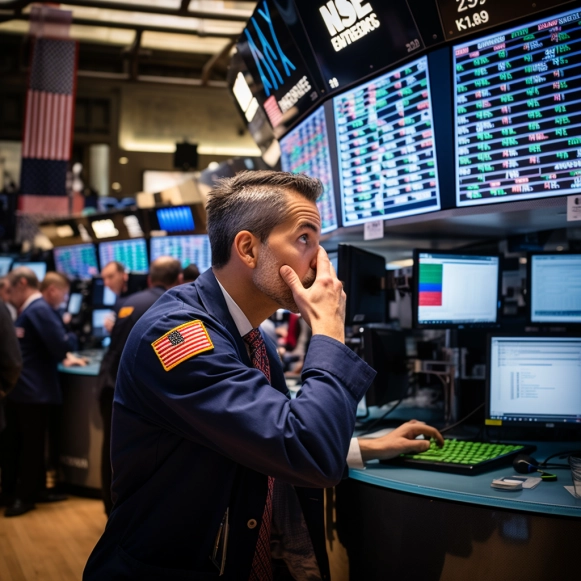Make these 5 investments as stocks climb to record highs in 2024, according to top strategists at Bank of America and BMO Capital Markets

- According to Bank of America and BMO Capital Markets, US stocks will reach new highs next year.
- The economy will continue to expand as concerns about rising inflation and interest rates subside.
- Here are five industries that investors should pay attention to in 2024.
Leading strategists at two trillion-dollar investment firms predict that US stocks will set new all-time highs in 2024, less than a year after calling for a recession.
Bank of America and BMO Capital Markets, which manage a combined $2.7 trillion in assets, expect the S&P 500 to reach 5,000 and 5,100 by the end of next year, respectively. Because the index is currently hovering around 4,550, those targets imply a 10% to 12% increase.
“Unlike last year, we are once again enthusiastic about stock market potential heading into 2024,” wrote Brian Belski, BMO’s chief investment strategist, in a note about his forecast for 2024.
“We believe US stocks will achieve another year of positive returns in 2024, albeit with more sanguine, broadly distributed, and fundamentally defined performance relative to the last decade or so,” Belski added. To put it another way, normal and typical.”
Positive signals require a pivot — no matter what bears say
Although Bank of America and BMO both predicted a recession late last year, both were willing to revise their pessimistic forecasts when economic growth outperformed expectations.
Bank of America’s head of US equity and quantitative strategy, Savita Subramanian, recently wrote that the US has moved past the “maximum macro uncertainty” of the post-pandemic recovery, when multi-decade-high inflation and rapid interest rate hikes triggered a selloff.
Despite higher productivity and consumer and corporate resilience, she noted that many investors remain wary of stocks.
“Pension equity weights are at 25-year lows, sell-side market targets are mostly underwater, consensus long-term earnings growth for the S&P 500 is at its lows (ex. COVID), and active funds are hugging their benchmarks,” Subramanian said in a note about her outlook for 2024. “Bull markets typically end with high conviction and euphoria — we are far from that.”
BMO’s Belski was even harsher on what he sees as obstinate bears.
“Unfortunately, bearish fear sells, and bulls are routinely doubted and panned,” Belski wrote in an email. “Get ready for another year of analysis paralysis of US Federal Reserve policy, the impacts of the ‘unflattening of the yield curve’ (instead of saying ‘steepening’), unemployment drifting higher, and of course the ‘Chicken Little recession’ and its market impact that has been apparently just around the corner for the past few years and counting due to the lag effects of higher inflation and interest rates.”
Belski claims that market sentiment is at its lowest point in his three-decade career. The strategy chief is on the opposing side, though he does not believe he is being overly optimistic.
“Call it goldilocks, nirvana; label it what you will,” Belski wrote in an email. “But an outlook for high-single to low-double-digit market performance is far from a ‘perma-bull’ moniker.”
Optimism about rates, earnings will support stocks
Since late October, US equities have surged, owing largely to falling inflation. Lower price growth will relieve pressure on consumers and profit margins, as well as allow the Federal Reserve to stop raising interest rates. Bank of America believes rate cuts will begin in June, though some market participants now expect rates to fall as soon as March.
“We’re bullish not because we expect the Fed to cut, but because of what the Fed has accomplished,” Subramanian said in a statement.
Even if interest rates continue to rise, Belski believes stocks will be fine. His research shows that when interest rates are high, the S&P 500 performs even better on a volatility-adjusted basis.
Lower interest rates would be welcomed by investors, even though corporate profits are typically the most important driver of stock returns. Bank of America and BMO both expect a sharp rebound from this year’s earnings recession, with Bank of America forecasting 6% growth from 2023 despite lower GDP, while BMO strategists forecast 13.6% growth.
“Unlike last year, we expect the P/E multiple to remain relatively static, with gains being driven primarily through earnings growth next year,” Belski said in a note.
According to Subramanian, BofA analysts are calling for slower inflation, higher profit margins, and increased efficiency. She went on to say that historical data dating back to 1950 shows that rising earnings growth and slowing GDP have resulted in the best environment for stocks.
Other tailwinds highlighted by Subramanian include a surge of US-based investment in response to geopolitical uncertainty, US energy security, higher oil prices that boost profits, the US dollar’s relative stability, and roughly $80 trillion in pent-up savings held by baby boomers.
5 top parts of the market to target now
While Bank of America and BMO have similar outlooks for the stock market and the economy, their strategies for maximizing gains in 2024 differ significantly — with one notable exception.
Both investment firms are bullish on financials, which they believe have historically been undervalued. Belski believes the group is the best value in the market, writing that they are “more hated now than in 2009.” The high-quality group, according to BofA, is overpriced now that regional bank meltdowns, which sparked fears of contagion risk earlier this year, have been contained.
Otherwise, Subramanian’s team disagrees with Belski’s. The only other sector in which BMO is bullish is information technology, which BofA recently downgraded from marketweight to underweight.
Belski expects technology in general to outperform, not just the so-called Magnificent 7, but he still advises caution. BofA recognizes technology’s strong balance sheets, margins, and earnings trends, but avoids the sector due to concerns about high valuations and government regulation.
Instead, BofA rates the energy, consumer discretionary, and real estate sectors favorably. BMO, on the other hand, is underweight in energy stocks and neutral in the other two.
Energy stands out to BofA because energy companies have no incentive to increase oil production, which should keep Brent crude prices high next year at around $90 per barrel. Warfare will also limit supply, though countries will continue to stockpile oil for national security reasons. As a result, energy producers will generate massive amounts of free cash flow, which will trickle down to shareholders.
However, according to Bank of America, energy is the lowest-quality market sector, and the continued push for renewable energy remains a long-term threat to oil firms. A resolution to the conflicts in Ukraine and Israel, as well as a recession, would be detrimental to oil prices. BMO is less bullish on energy stocks because they have lagged behind oil prices in the last year.
Subramanian wrote that consumer discretionary is a good bet if interest rate hikes are over and consumers continue to spend. Furthermore, both hedge funds and long-only funds are significantly underweight the group, providing upside if managers are forced to catch up.
However, both investment firms highlighted what they believe is the most significant risk to that consumer-focused group: only two stocks — Tesla (TSLA) and Amazon (AMZN) — account for half of the sector. While BMO is not shorting consumers by underweighting the sector, it does encourage investors to be selective in consumer discretionary stocks.
Finally, Bank of America believes that because hedge funds and long-only funds are ignoring real estate, it offers investors a high dividend yield at a low valuation.
BMO cited the group’s consistent payouts, though it noted that fears of a sector downturn are widespread. BofA is aware of the risk, but believes it is exaggerated. Property prices are falling in some markets, but few expect widespread drops in home equity.






